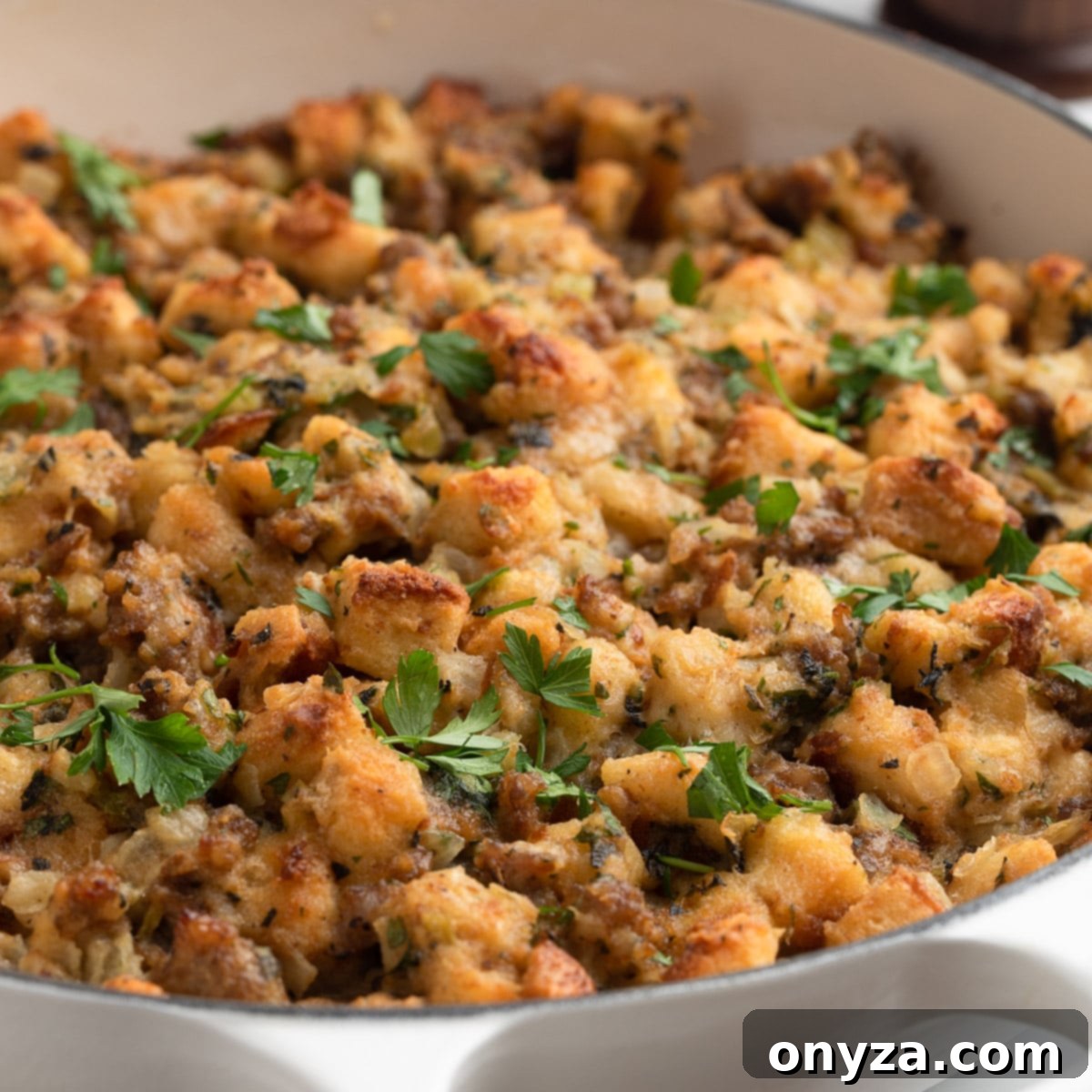Searching for diverse stuffing ideas? Discover our Classic Herb Bread Stuffing, delightful Cranberry-Pecan Stuffing (featuring both white and wheat breads), or our robust Sausage and Chestnut Stuffing (a delicious blend of cornbread and white bread).
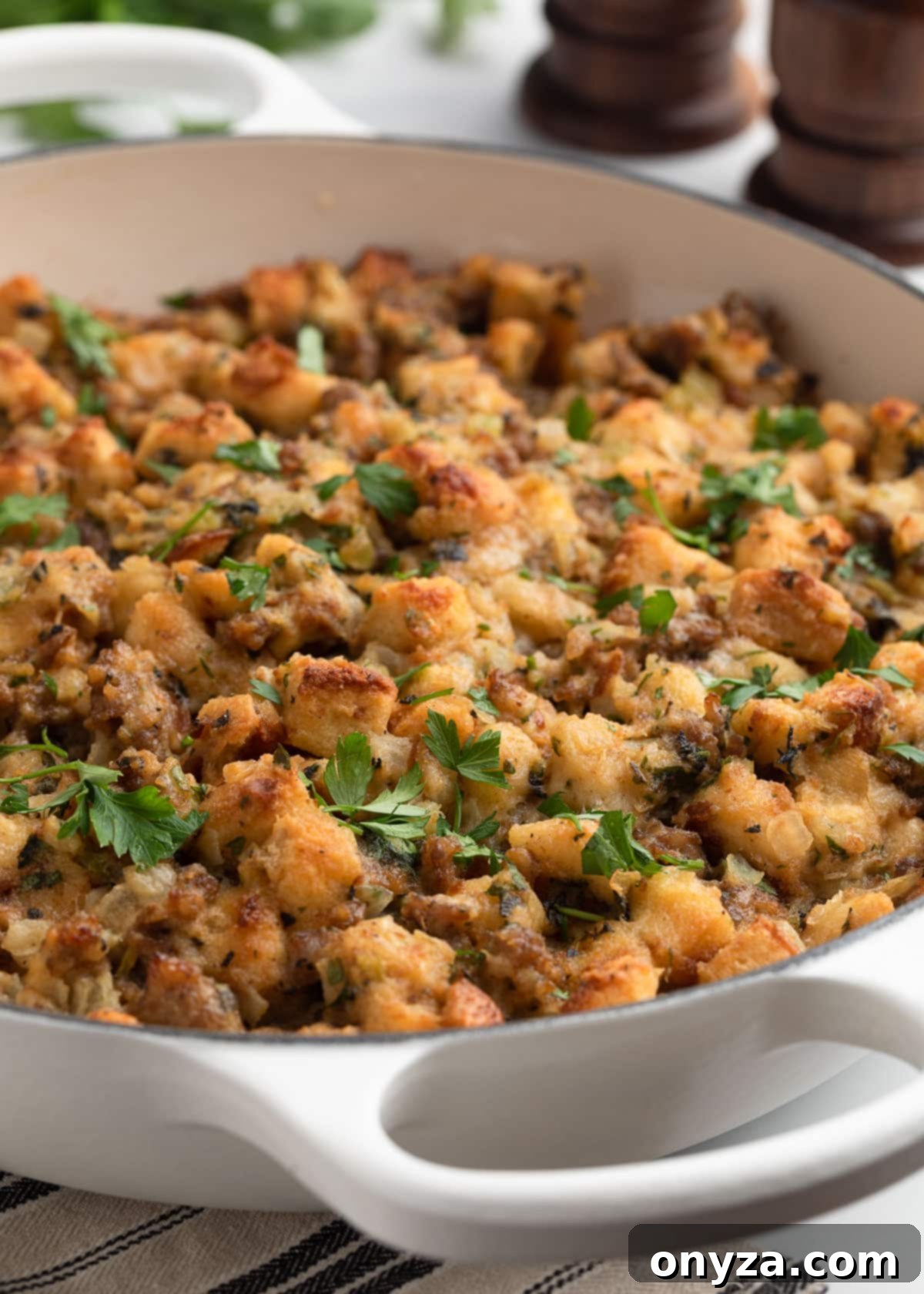
The Ultimate Italian Sausage Stuffing with Parmesan and Herbs
There’s an undeniable magic to Thanksgiving stuffing, a dish that often steals the show right alongside the roasted turkey. While I enjoy experimenting with various stuffing (or dressing) recipes on my holiday menu, one recipe always receives an enthusiastic request from my family: our cherished Italian Sausage Stuffing. This isn’t just any stuffing; it’s a rich tapestry of savory Italian sausage, finely grated Parmigiano Reggiano, and a medley of fresh herbs that create a truly comforting and deeply flavorful experience. It’s a perfect culinary partner for succulent turkey, designed to impress with every spoonful.
This recipe transforms simple ingredients into a festive masterpiece, striking a delightful balance between robust, savory notes and the subtle freshness of herbs. It’s a testament to the power of quality components and thoughtful preparation, ensuring a memorable addition to your holiday spread year after year.
Why This Italian Sausage Stuffing is a Holiday Must-Have
What elevates this Italian Sausage Stuffing above the rest? It’s a harmonious blend of textures and tastes that come together to create an unforgettable side dish. The savory, spiced Italian sausage provides a hearty backbone, complementing the richness of the turkey without overpowering it. Freshly grated Parmigiano Reggiano introduces a nutty, salty depth, infusing the entire dish with an authentic Italian essence that makes it uniquely special.
Unlike many stuffing recipes that can become bland or overly moist, this Italian Sausage Stuffing achieves a perfect balance: a fluffy, moist interior with delightfully crisp, golden-brown edges. This textural contrast, combined with the vibrant flavors of sage, thyme, and parsley, ensures that every bite is exciting and comforting. It’s a truly satisfying dish that embodies the spirit of holiday feasting, making it a perennial family favorite and a highlight of any celebratory meal.
Essential Preparations: What You Need to Know
To ensure your Italian Sausage Stuffing is a resounding success, thoughtful preparation is key. Here’s a deeper dive into the essential components and strategic planning tips:
- Bread: The Foundation of Fluffy Stuffing
You’ll need a substantial 1½-pound (24-ounce) loaf of hearty white bread. Over years of perfecting this recipe, I’ve found that robust sandwich breads like Arnold Country White and Pepperidge Farm Farmhouse White consistently yield the ideal fluffy, yet structured, stuffing texture. Avoid using light, airy breads that can turn mushy. Use the entire loaf—crusts and ends included—as these add flavor and character. If your chosen bread has a particularly hard or thick crust, it’s best to trim it off to ensure uniform softness in the final product. The goal is to create croutons that are thoroughly dried out, allowing them to absorb the rich broth without becoming soggy. - Plan Ahead: Maximizing Flavor and Minimizing Stress
Drying the bread cubes in the oven is a crucial step that requires time, making it an ideal task for advance preparation. I highly recommend prepping your croutons up to 5 days before the main holiday event. Once baked and completely cooled, store these perfectly dry croutons in an airtight container at room temperature. This foresight significantly streamlines your cooking process on the big day, allowing you to focus on the more immediate steps. - Broth/Stock: The Key to Richness and Control
For unparalleled depth of flavor, I always reach for my Make-Ahead Turkey Stock. Its rich, nuanced profile and neutral salt level allow for precise seasoning control, ensuring your stuffing is perfectly balanced. If homemade stock isn’t an option, a high-quality, store-bought low-sodium chicken or turkey broth works wonderfully. Opting for low-sodium broth is critical as it empowers you to manage the overall salt content of the stuffing, adjusting it to your preference without over-salting the dish. If using frozen homemade stock, ensure it’s fully thawed and gently warmed if it has gelled to achieve a pourable consistency. - Sausage: Choosing Your Flavor Profile
Sweet Italian sausage, with its distinctive fennel notes, is my preferred choice for this family recipe, contributing a classic and comforting flavor. However, if you enjoy a touch of heat, feel free to use hot Italian sausage or a combination of sweet and hot for a more dynamic profile. For the most authentic and delicious results, if you have access to an Italian market that makes its own house-made sausage, it’s an exceptional choice that will elevate your stuffing significantly. - Parmigiano Reggiano: The Essence of Italian Flavor
The quality of your cheese makes a remarkable difference. Always finely grate Parmigiano Reggiano directly from a wedge. Pre-grated cheeses often contain anti-caking agents that can affect texture and lack the fresh, robust, nutty, and salty flavor that is so integral to this stuffing’s special character. This cheese is not merely an addition; it’s one of the star elements that infuses the dish with its signature Italian warmth. - Fresh Herbs: Aromatic Heart of the Stuffing
Fresh herbs are indispensable for this recipe, providing bright, aromatic notes that tie all the flavors together. You’ll be using finely chopped sage, thyme, and flat-leaf parsley. Sage delivers a warm, earthy, slightly peppery flavor, quintessential for holiday dishes. Thyme offers delicate, minty, and citrusy undertones, while flat-leaf parsley adds a fresh, clean finish. Chopping them just before use ensures their potent oils are at their peak for maximum flavor.
Crafting Your Italian Sausage Stuffing: A Step-by-Step Guide
Bringing this incredible Italian Sausage Stuffing to life is a rewarding process. Follow these detailed steps to achieve a dish that’s rich in flavor, perfect in texture, and truly memorable.
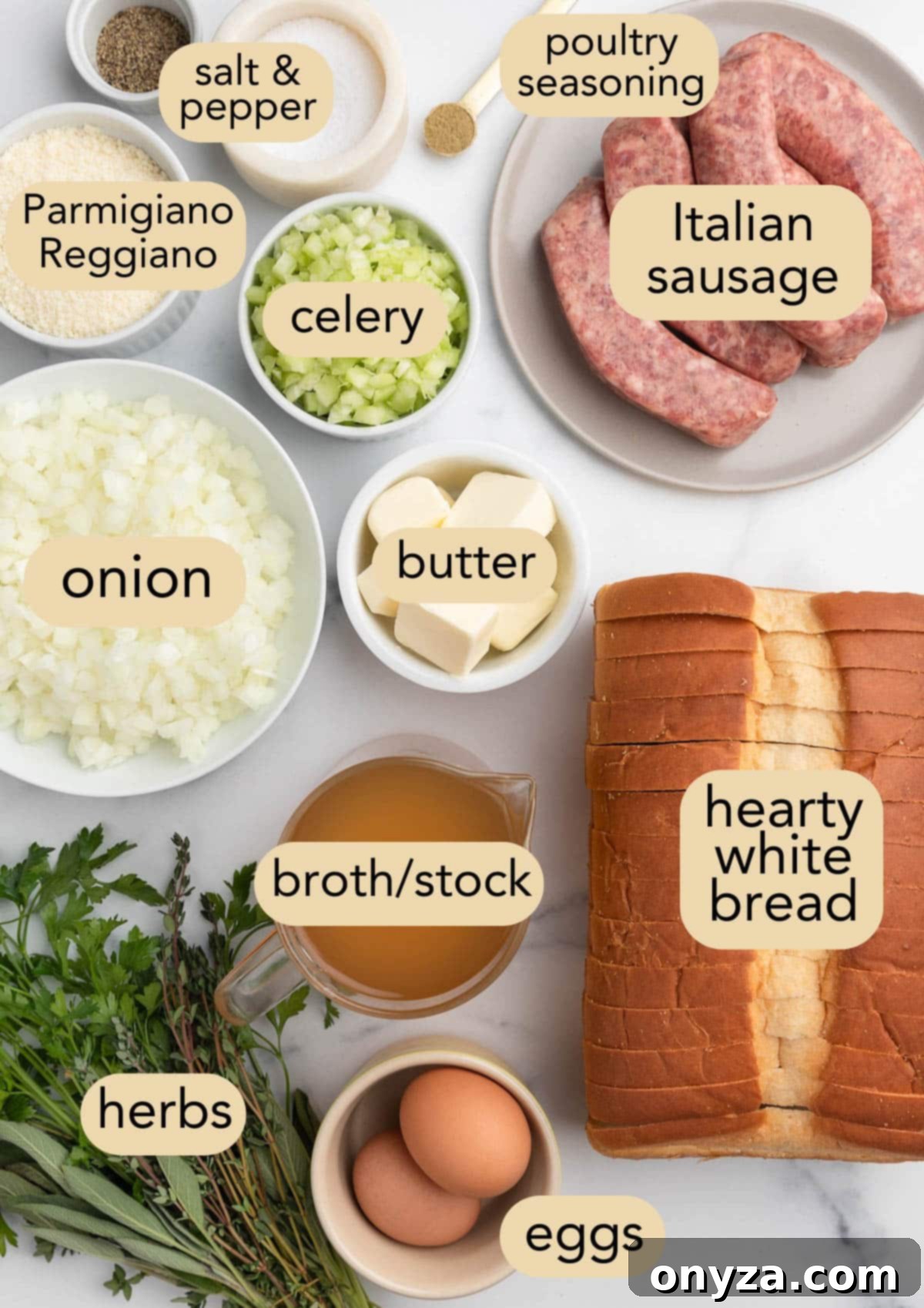
Step 1: Preparing the Perfect Croutons
The foundation of great stuffing lies in perfectly dried bread cubes. Begin by slicing your chosen hearty white bread into uniform ½- to ¾-inch cubes. A good serrated knife will make this task effortless, and stacking a few slices at a time can significantly speed up the process.
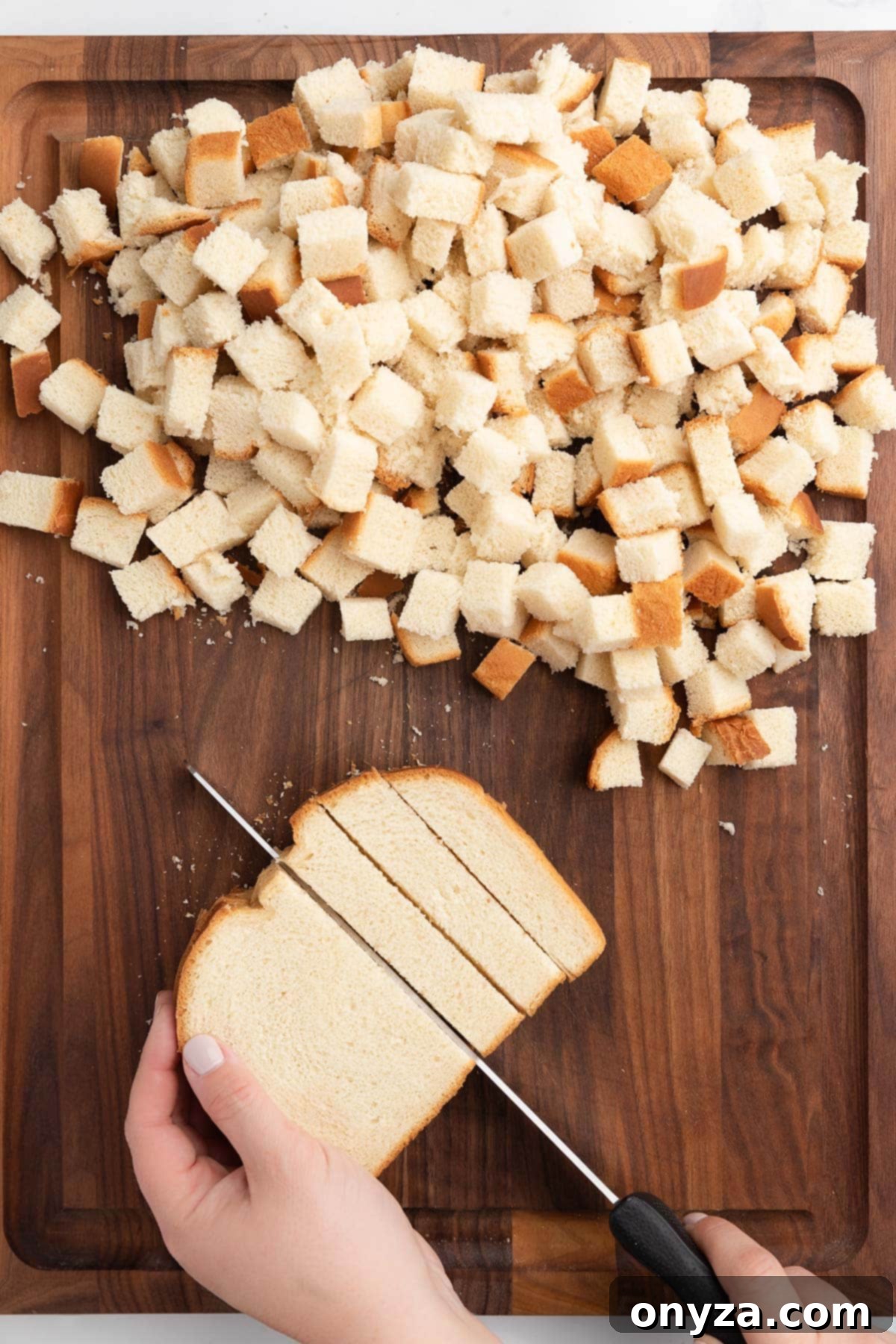

Once cubed, spread the bread pieces into a single, even layer across two rimmed half-sheet pans. This ensures even drying and prevents steaming. Bake them in a preheated oven at a low temperature of 250°F for 50–60 minutes. Midway through the baking time, give the bread cubes a good stir and rotate the pans to promote consistent drying and light toasting.
The ideal crouton should be completely dried out, firm to the touch, with only the slightest hint of golden color. They should not be hard like store-bought croutons, but rather thoroughly moisture-free. Allow the croutons to cool completely at room temperature before proceeding. This step is crucial for preventing a soggy stuffing and allowing the bread to properly absorb the liquids later on.

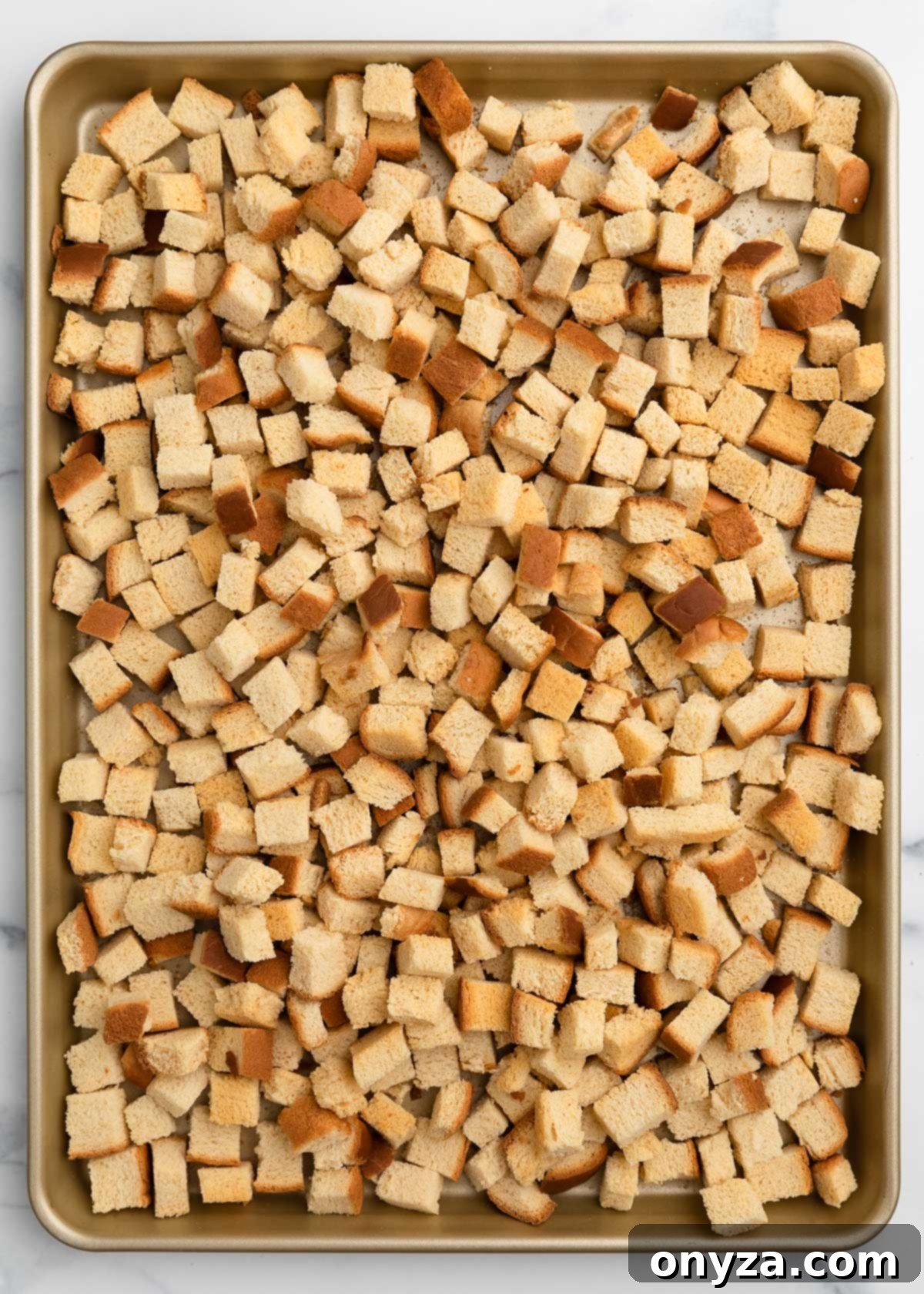
Step 2: Preparing Your Flavorful Add-Ins
Efficiently preparing your stuffing’s supporting ingredients before you start cooking is the secret to a smooth and enjoyable process. This mise en place ensures everything is ready when you need it.
- Aromatics. Precision dicing is important here. Dice the celery and onions into uniform ¼-inch pieces. This ensures they cook evenly and soften perfectly, melting into the stuffing. For celery, a pro tip: I usually run a vegetable peeler down the outside of the stalks first. This removes any tougher strings that might otherwise remain firm and fibrous in the finished stuffing, ensuring a smooth texture. Once diced, finely chop your fresh herbs: sage, thyme, and flat-leaf parsley. The aroma alone will begin to build anticipation!
- Parmesan. For the richest flavor and best texture, grate the Parmigiano Reggiano yourself from a solid wedge. Its distinct nutty, salty profile is one of the foundational elements that makes this Italian stuffing truly exceptional and contributes significantly to its depth. Pre-grated cheese often lacks this intensity.
- Sausage. If you’re using Italian sausage that comes in links (rather than loose or bulk sausage), it’s important to remove the casings. Simply make a shallow slit lengthwise along each link with a sharp knife and peel the casing off. This allows the sausage to crumble and brown beautifully, releasing all its savory flavor into the dish.
- Broth or Stock. If you’ve opted for homemade turkey stock that was previously frozen, ensure it is fully thawed before use. Chilled homemade stock will naturally gel, so gently warm it until it becomes fluid and easily pourable. Store-bought broth can be used at room temperature, but avoid it being cold as it can lower the temperature of your sautéed vegetables.
- Eggs & Butter. Have your two large eggs ready to whisk with a portion of the broth later on. Ensure your unsalted butter is at room temperature to melt smoothly in the pan. The butter is crucial for both cooking the aromatics and contributing to the stuffing’s moist richness.
Step 3: Sautéing the Sausage and Vegetables to Perfection
This stage builds the core flavor profile of your stuffing, so don’t rush it!
Place a large nonstick skillet or sauté pan over medium-high heat. Add 2 tablespoons of butter and allow it to melt completely. Once shimmering, add the Italian sausage. Using a wooden spoon, break the sausage into bite-sized crumbles as it cooks. The key here is to brown the sausage thoroughly. Deeply browned sausage develops a richer, more complex flavor that will permeate the entire stuffing. Ensure it is fully cooked through before moving on.

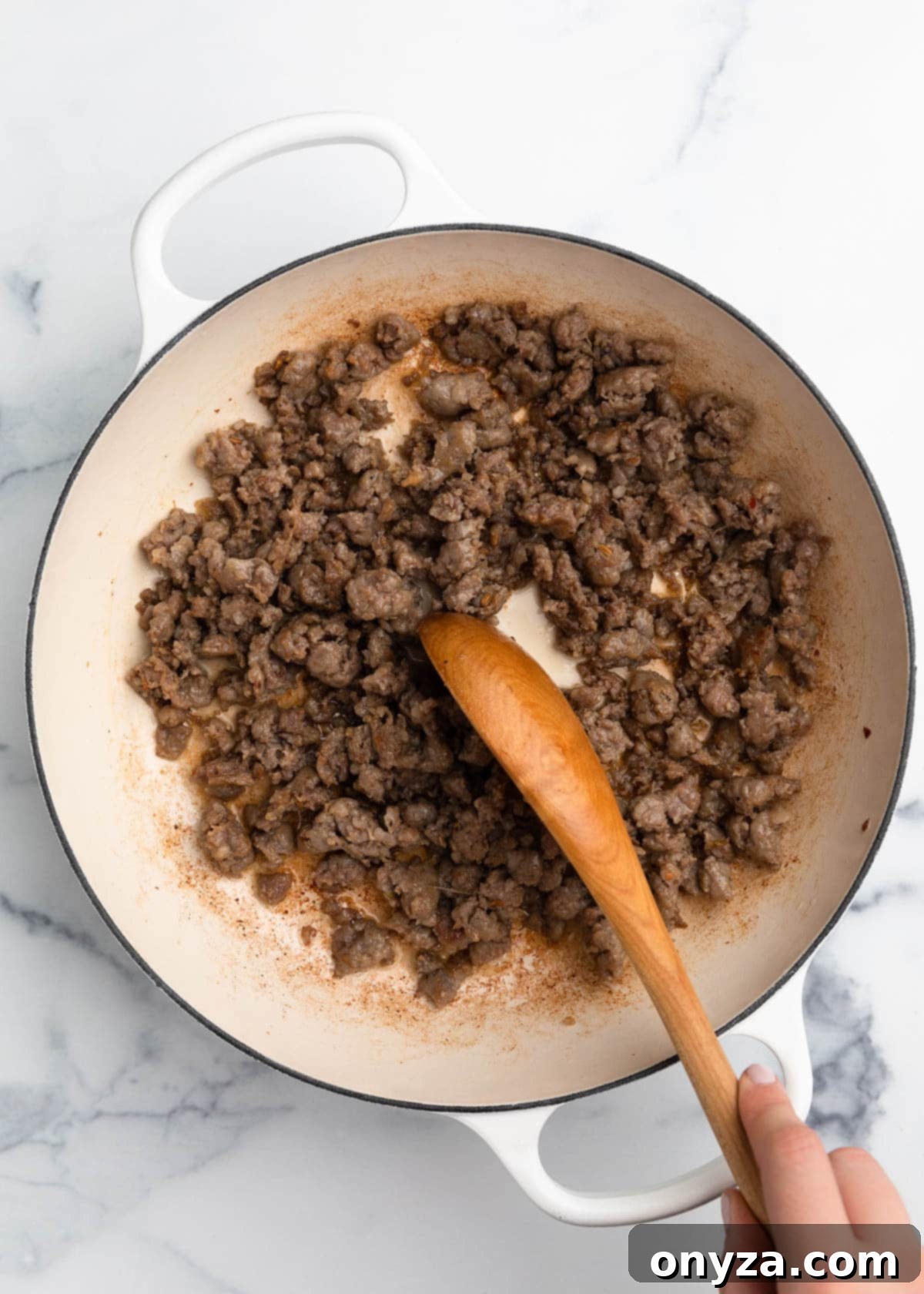
Once the sausage is beautifully browned and cooked, use a slotted spoon to transfer it into a large mixing bowl. Make sure to leave all those flavorful drippings and rendered fat behind in the skillet; these are liquid gold for your vegetables.
Add another 6 tablespoons of unsalted butter to the pan with the sausage drippings. As soon as it melts, stir in your diced celery and onions. Cook these aromatics over medium heat for 8 to 10 minutes, stirring occasionally, until they are tender and translucent but not browned. You’re not aiming for caramelization here; tender vegetables seamlessly meld into the stuffing and act as excellent carriers for the delicate flavors of the herbs.

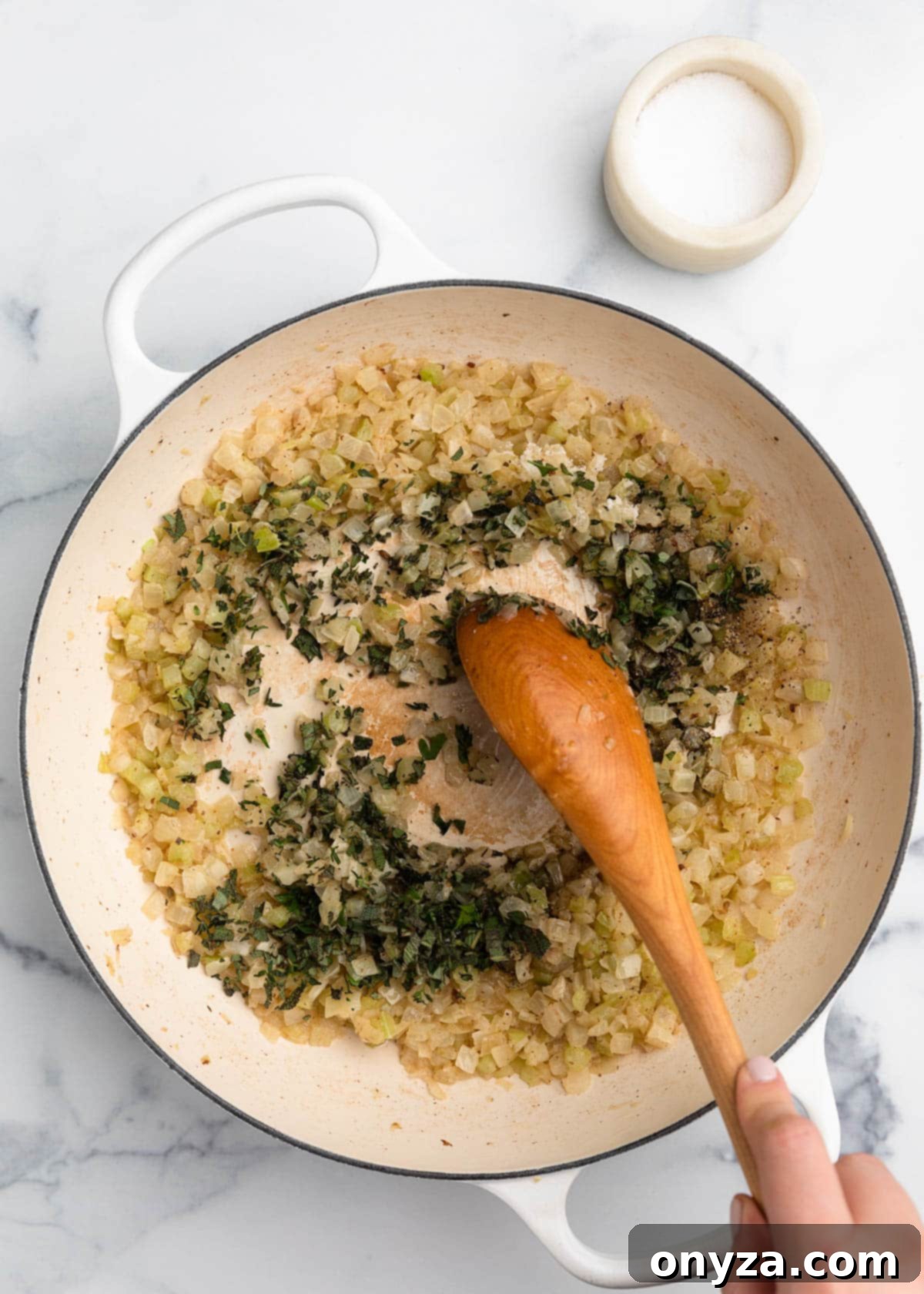
Once the vegetables have softened, sprinkle in the chopped sage and thyme, along with a touch of poultry seasoning, salt, and pepper. For poultry seasoning, I consistently use Bell’s Seasoning because it’s salt-free and masterfully boosts the natural flavors of the fresh herbs without overwhelming the dish. Cook everything together for another minute or two, just until the herbs become wonderfully fragrant. At this point, your kitchen should be filled with the quintessential aromas of a holiday feast!
Step 4: Assembling the Stuffing for Optimal Flavor and Texture
Now, it’s time to bring all those delicious components together, building the final texture and taste of your stuffing.
To the large mixing bowl containing the cooked sausage, add the cooled croutons. Pour the sautéed vegetable mixture over the top, making sure to scrape every last bit of that herb-infused butter and flavorful drippings from the pan. These are essential for depth of flavor!
Next, add the chopped fresh parsley and the generous amount of grated Parmigiano Reggiano. Gently toss the mixture to ensure all the ingredients are evenly distributed. Be mindful not to crush the croutons; you want them to remain distinct.
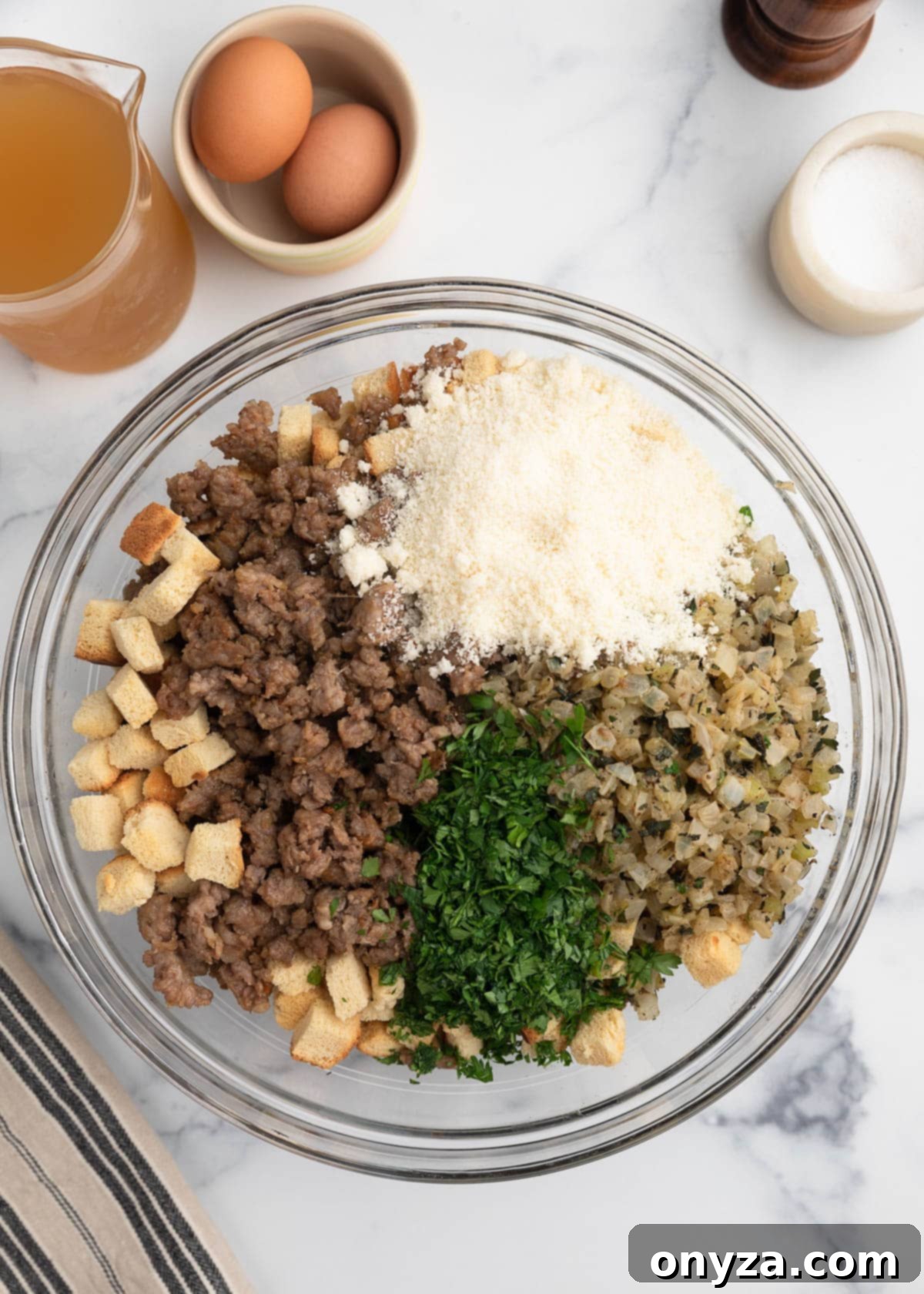
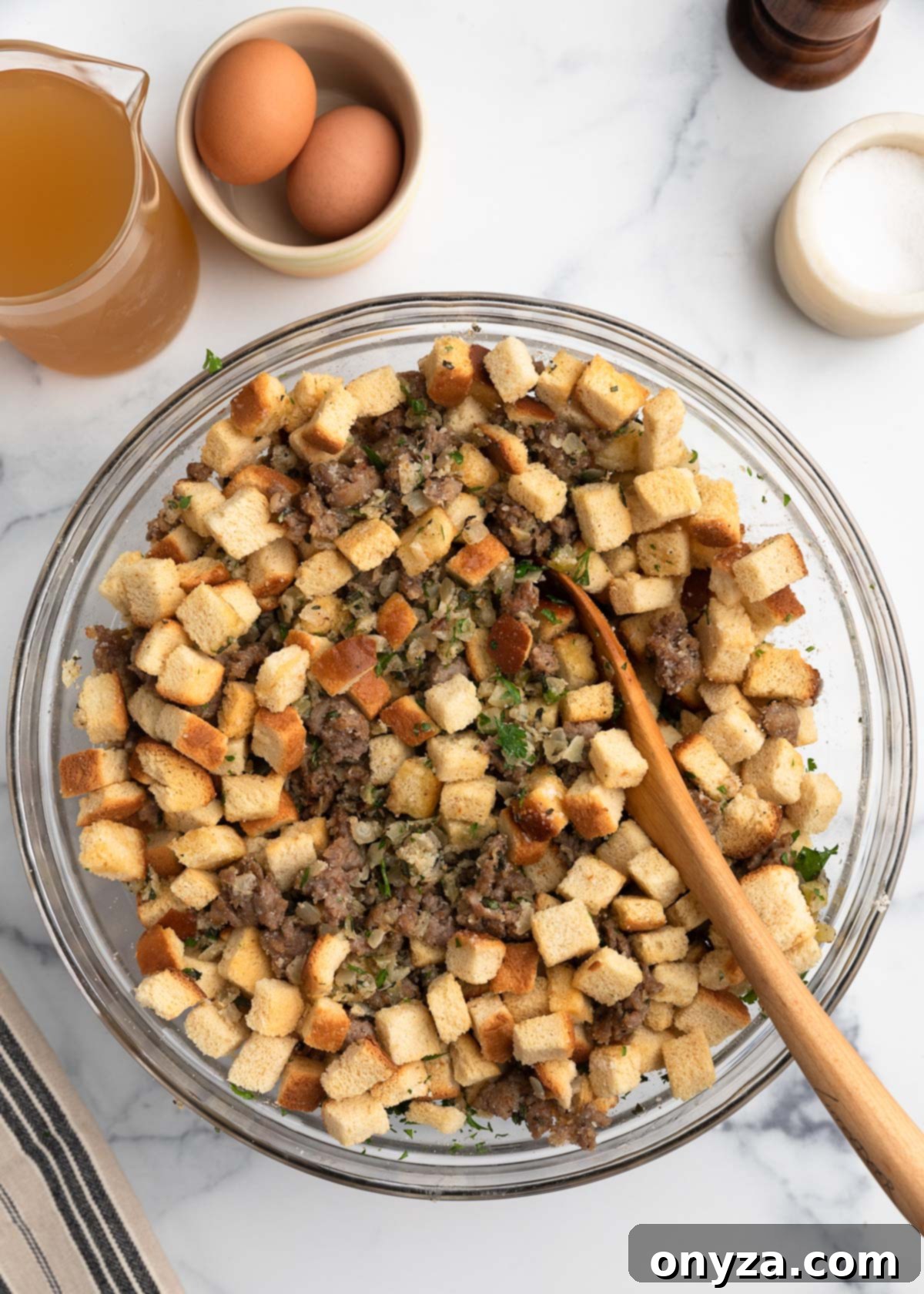
Now for the critical step of adding moisture. Begin by pouring in 1¾ cups of your low-sodium turkey or chicken stock. Mix everything well, then allow the bread to sit for a few minutes. This brief pause gives the croutons a chance to begin soaking up the flavorful liquid. After this initial absorption, take a small spoonful and taste the mixture. This is your last opportunity to adjust the seasoning—add more salt and pepper as needed—before the raw eggs are incorporated.
In a separate bowl, whisk the two large eggs with an additional ½ cup of stock. Drizzle this egg-and-broth mixture evenly over the stuffing and toss again gently. Let it rest briefly once more, allowing the bread to absorb this second round of liquid. The eggs act as a binder, helping the stuffing hold its shape while contributing to a moist, cohesive texture.
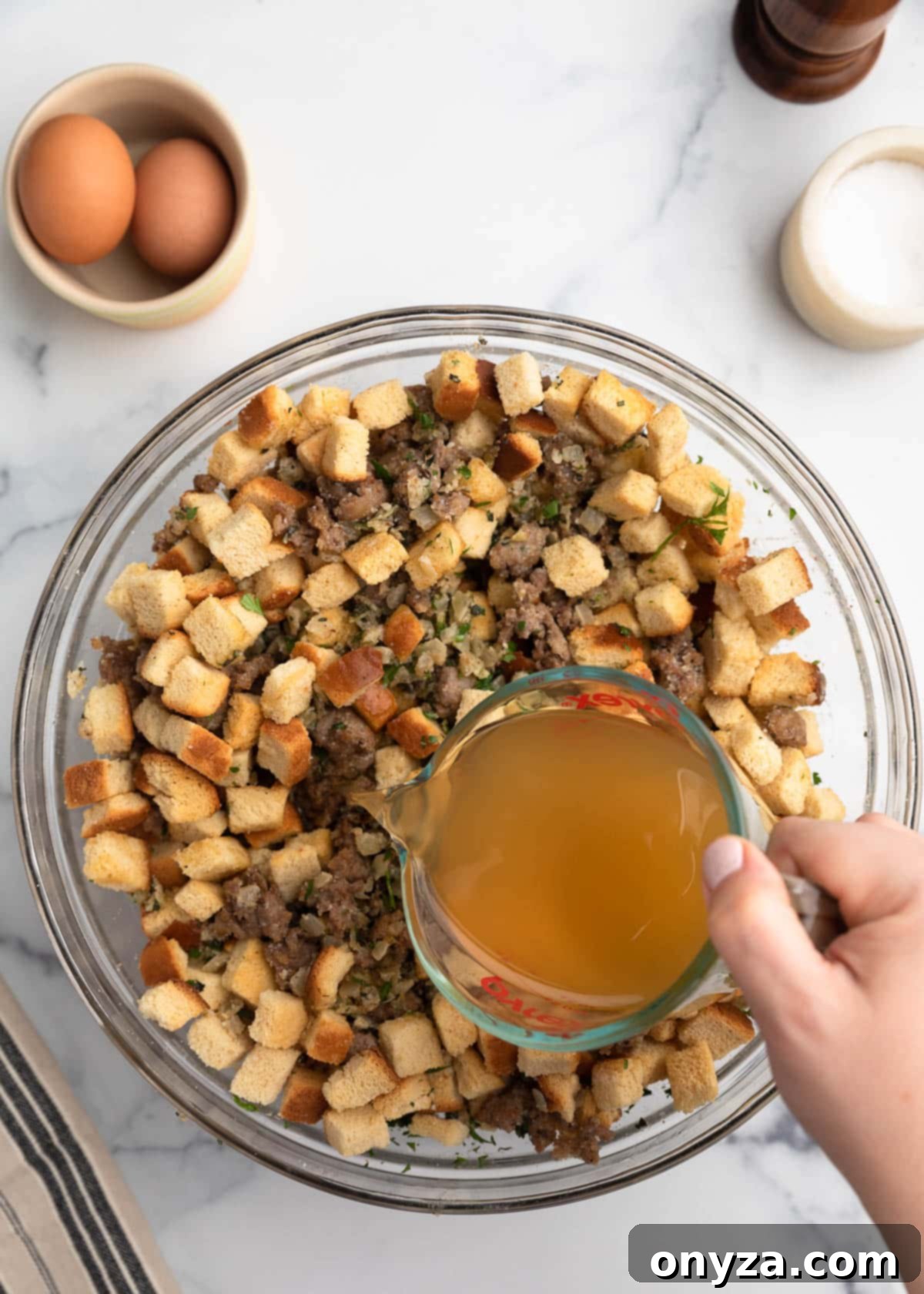

To confirm you’ve achieved the perfect moisture level, pick up a single crouton from the mixture and gently press it between your fingers. It should feel thoroughly moistened but still retain its shape—it should neither be dry and crumbly nor soggy and collapsing. If the mixture still feels a bit dry, add more broth gradually, about ¼ cup at a time, pausing after each addition to allow the bread to fully absorb the liquid. Remember, every loaf of bread behaves slightly differently, so trust your instincts and adjust based on what you see and feel.
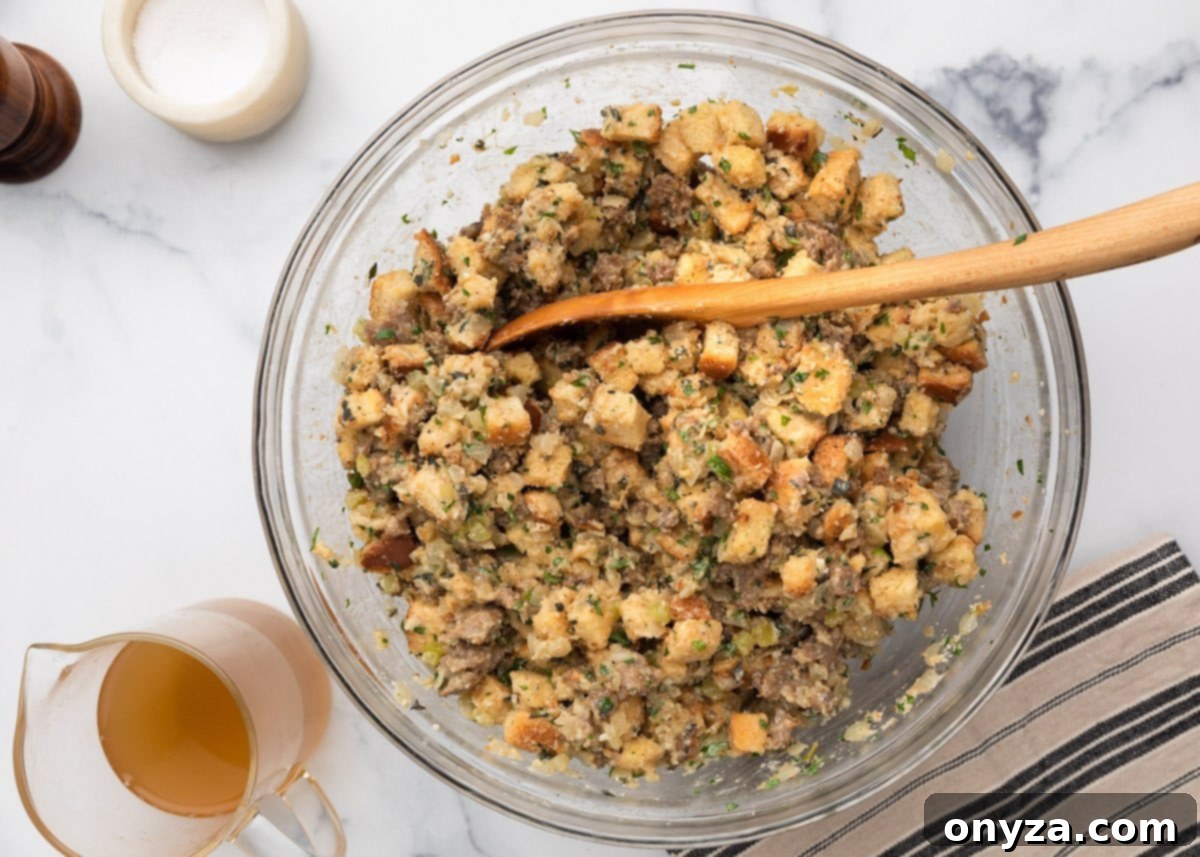
Step 5: Baking Your Stuffing to Golden Perfection
The final step is to bake your assembled stuffing, transforming it into a golden, aromatic masterpiece.
Carefully transfer the stuffing mixture to a buttered 3-quart gratin dish or a 13×9-inch baking dish. Spread the mixture into an even layer, but resist the urge to pack it down tightly. Leaving it slightly loose is key to allowing those delicious, crispy edges to form in the oven—a favorite for many stuffing enthusiasts.
Cut the remaining 2 tablespoons of unsalted butter into small pieces and artfully scatter them across the top surface of the stuffing. As the butter melts, it will contribute an extra layer of richness and help the stuffing bake to a beautiful golden-brown color with delightfully crisp peaks and edges.

Cover the dish snugly with aluminum foil. This traps moisture during the initial baking phase, ensuring the interior of the stuffing remains moist and tender. Place the covered dish into a preheated 375°F oven and bake for 30 minutes. After this time, remove the foil and allow the stuffing to continue baking uncovered for another 15–20 minutes. During this phase, the surface will become deeply golden and delightfully crisp. You’re looking for a top that’s beautifully browned in spots, with irresistibly crunchy edges. For food safety, the center of the stuffing should register 165°F on an instant-read thermometer.
Once baked to perfection, remove the stuffing from the oven and let it rest for approximately 10 minutes. This brief pause is crucial; it allows the interior to set just enough, making it easier to scoop and ensuring it retains its wonderful texture. Garnish with a sprinkle of fresh parsley before serving.
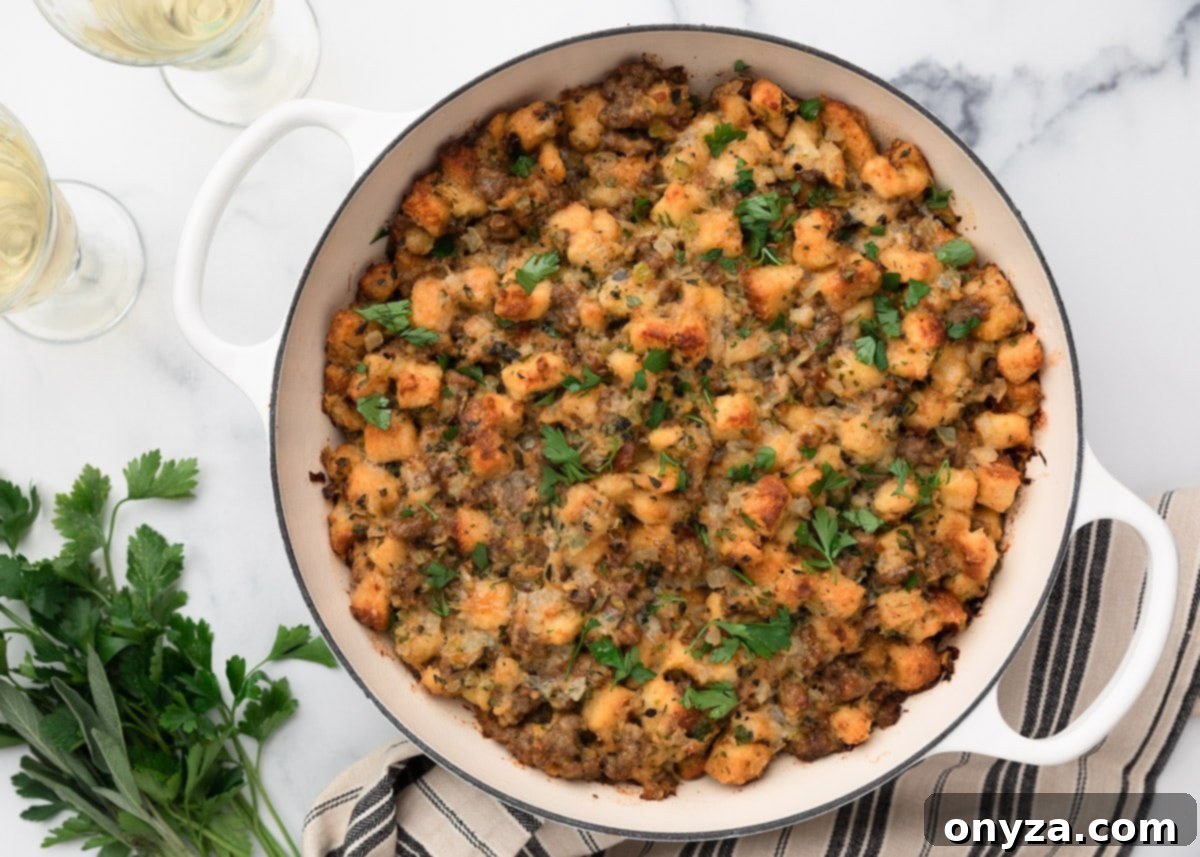
Serving Your Delectable Italian Sausage Stuffing
Presenting this Italian Sausage Stuffing is almost as satisfying as making it. Just before bringing it to the table, I like to sprinkle a little extra chopped fresh parsley over the top. This adds a vibrant pop of color and a final hint of fresh aroma, making the dish even more appealing.
This savory stuffing is an impeccable pairing for classic holiday meats. It’s absolutely wonderful served alongside roasted turkey, especially my Herb Roasted Turkey Breast, where the Italian flavors beautifully complement the poultry. It’s also surprisingly delicious with a simple roasted chicken, elevating an everyday meal into something special.
When serving, be sure to scoop all the way to the edges of the baking dish—everyone in my family (and yours likely will too!) always gravitates towards those coveted crispy bits first! Italian Sausage Stuffing seamlessly fits into both intimate holiday gatherings and elaborate feasts with multiple side dishes. It’s particularly delightful with a generous drizzle of rich, homemade turkey gravy, which adds an extra layer of moistness and savory indulgence.
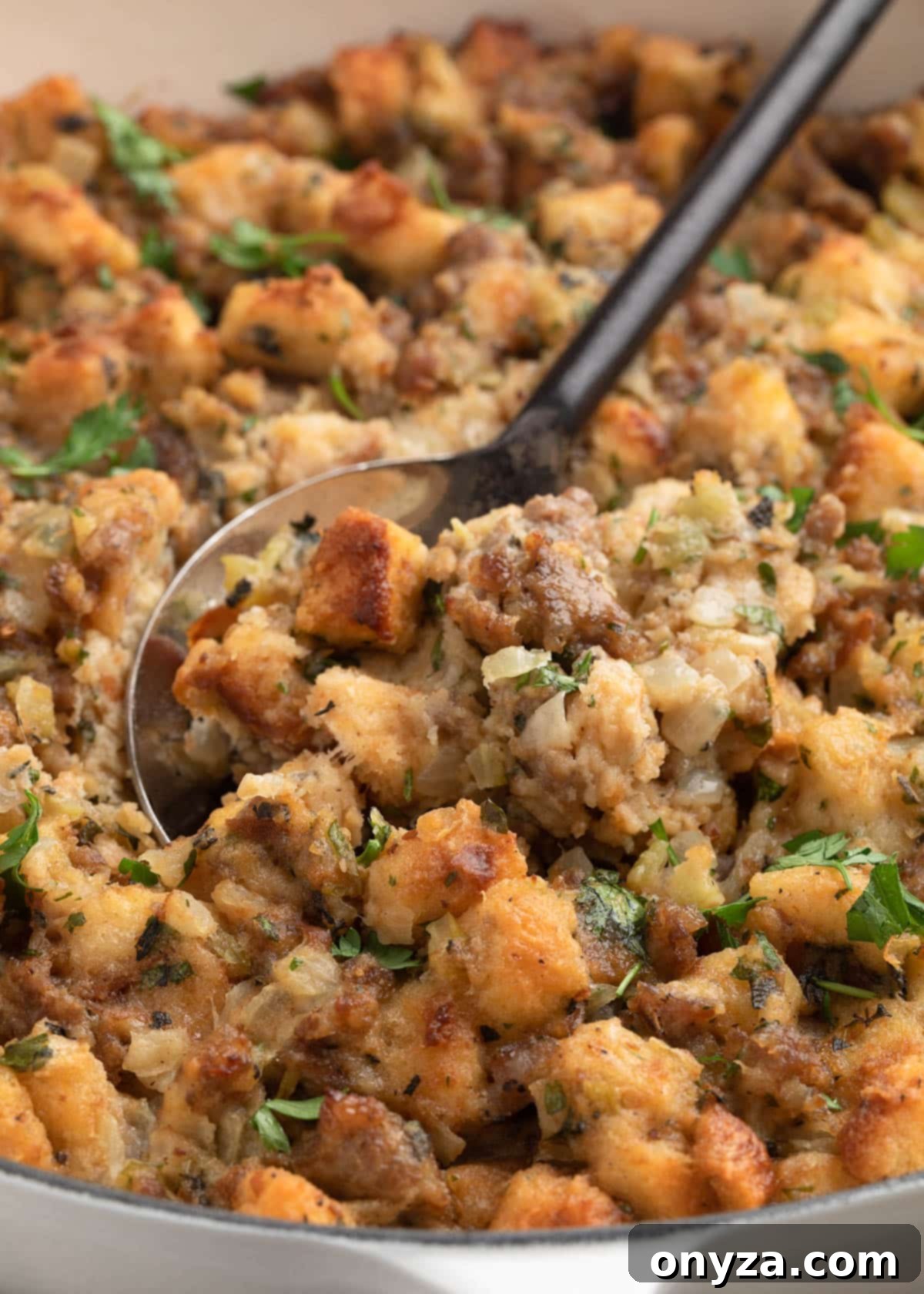
Keeping Your Stuffing Warm and Delicious
If you’re not serving your Italian Sausage Stuffing immediately, it’s easy to keep it warm without compromising its deliciousness. Transfer it to a 200–250°F oven, covered snugly with foil, or use a covered chafing dish. For the best texture and to prevent it from drying out, aim to hold it for no more than 30–45 minutes. Always ensure the center remains above 140°F for optimal food safety.
Should the stuffing begin to lose some moisture, a gentle drizzle of warm broth will quickly bring its perfect texture right back, ensuring every serving is as good as the first.
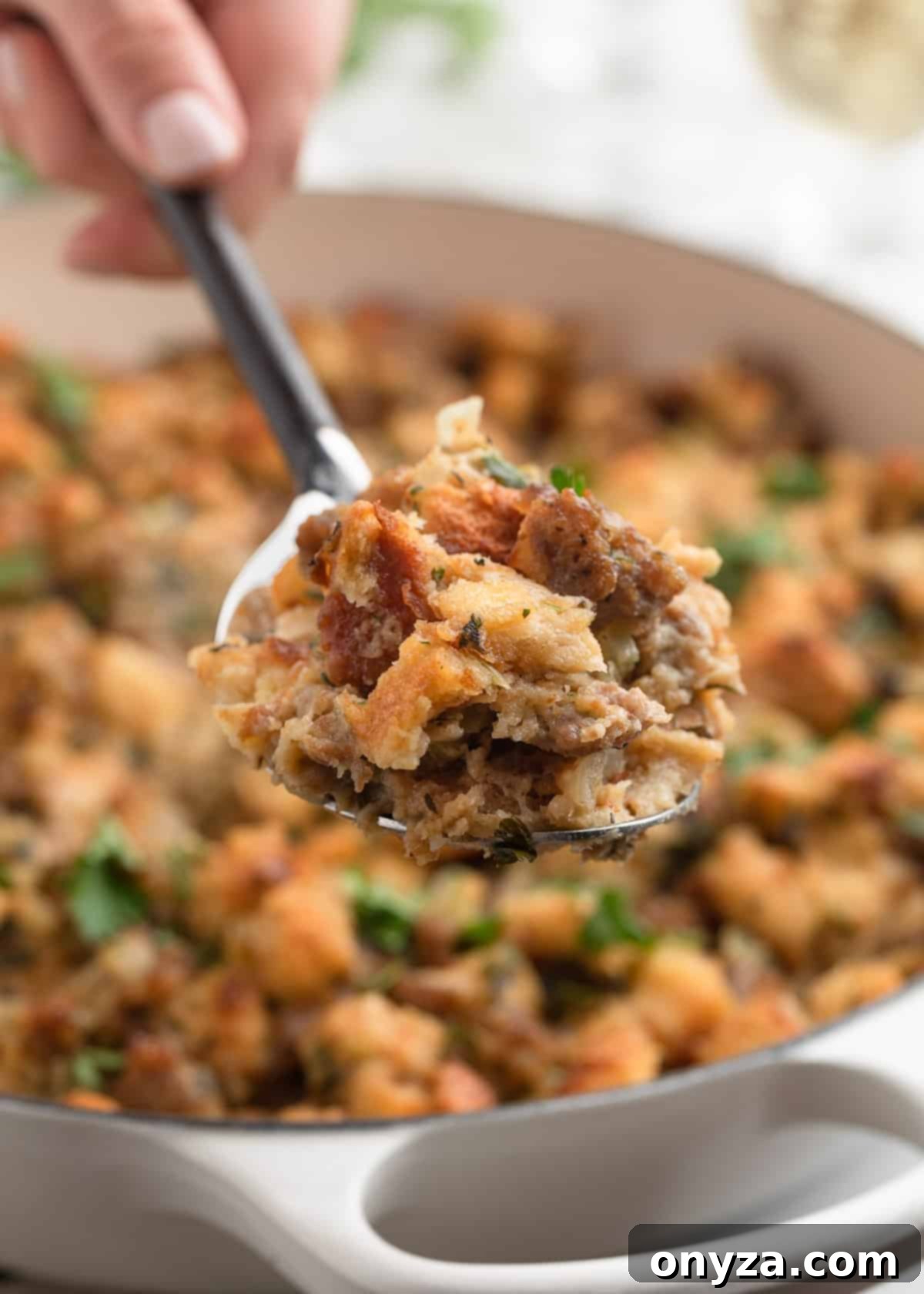
Smart Make-Ahead Strategies for Stress-Free Holidays
Stuffing is often a centerpiece of holiday meals, and preparing it in advance can significantly reduce stress. However, it’s crucial to adhere to food-safety guidelines to ensure your dish is both delicious and safe. The USDA advises against refrigerating fully assembled, unbaked stuffing, even when kept cold, as the moist mixture can become a breeding ground for bacteria. (Their article, Stuffing and Food Safety, provides further detailed explanations).
Thankfully, you can still get a significant head start on this Italian Sausage Stuffing recipe by prepping several key elements ahead of time, ensuring a smoother holiday cooking experience:
- Vegetable Prep: Chop the celery and onions 1-2 days before you plan to assemble and bake the stuffing. Store them securely in airtight containers in the refrigerator. While many ingredients can be prepped, I always save chopping the fresh herbs for the actual day I make the stuffing—they offer the brightest and most potent flavor when freshly cut.
- Parmesan Prep: Your Parmesan can be grated a day or two in advance. Store it covered tightly in the refrigerator to maintain its freshness and flavor.
- Crouton Perfection: As mentioned earlier, preparing the bread croutons a few days before the holiday is an excellent strategy. This allows them to cool completely and be perfectly dried and ready for assembly when you are. Properly dried croutons are the secret to a stuffing that’s never soggy.
If your goal is to have the stuffing completely prepared ahead of the holiday, freezing is the safest and most effective approach. Assemble the stuffing as directed, then spoon it into a buttered freezer-to-oven-safe dish. Cover it tightly with a double layer of aluminum foil, or use a freezer-safe lid, and freeze for up to 3 months.
To bake from frozen, there’s no need to thaw! Simply place the covered dish directly into a 350°F oven and bake for approximately 1 hour. After this initial baking, increase the oven temperature to 375°F, remove the foil, and continue baking for an additional 15–20 minutes. This final uncovered bake allows the top to achieve that desirable golden crispness, ensuring a perfectly heated interior that reaches a safe internal temperature of 165°F.
Stuffing Variations and Expert Tips for Success
While this classic Italian Sausage Stuffing is a masterpiece on its own, don’t hesitate to personalize it. Here are some ideas and general tips to make your stuffing truly shine:
Creative Variations to Try
- Add Fruit for Sweetness: For a touch of sweetness and texture, consider folding in ½ cup of dried cranberries or chopped dried apricots during the assembly stage. Their tartness will beautifully complement the savory sausage.
- Nutty Crunch: Toasted pecans, walnuts, or pine nuts (pignoli) can add a delightful crunch and earthy flavor. Add about ½ cup along with the fresh parsley and Parmesan.
- Different Cheeses: While Parmigiano Reggiano is traditional, try blending in some grated Pecorino Romano for a sharper, saltier kick, or a touch of Fontina for a meltier, milder creaminess.
- Mushroom Magic: Sautéed sliced mushrooms (cremini or shiitake) can add an extra layer of umami. Add them to the pan after the celery and onions have softened, and cook until their liquid has evaporated.
- Spice it Up: For those who love more heat, in addition to hot Italian sausage, a pinch of red pepper flakes can be added when cooking the aromatics.
- Vegetarian Option: Omit the sausage and instead increase the vegetables (e.g., add bell peppers or more celery). Consider adding a generous amount of robust mushrooms or plant-based sausage alternatives to retain a hearty quality.
Expert Tips for Stuffing Success
- Don’t Overcrowd the Pan: When browning sausage or sautéing vegetables, ensure your skillet isn’t too crowded. Overcrowding lowers the pan temperature and steams the ingredients instead of browning them, which can lead to less flavorful results. Cook in batches if necessary.
- Taste as You Go: This is paramount for any recipe, especially one like stuffing where broth and sausage saltiness can vary. Taste the sausage and vegetable mixture before adding it to the bread, and critically, taste the moistened bread mixture before incorporating the raw eggs. Adjust salt, pepper, and even herbs as needed.
- Don’t Pack it Too Tight: When transferring the stuffing to the baking dish, spread it loosely. Packing it down too much will prevent the desired crispy edges from forming and can result in a denser, less airy stuffing.
- Butter is Your Friend: Don’t skimp on butter, especially dotting it on top before baking. It ensures a beautiful golden crust and adds incredible flavor and richness.
- Internal Temperature is Key: Always use a meat thermometer to check for doneness. Stuffing should reach an internal temperature of 165°F (74°C) to be safe for consumption, especially when containing meat and eggs.
Explore More Homemade Stuffing (Dressing) Recipes
If you loved this Italian Sausage Stuffing, you’ll surely enjoy exploring other delicious variations for your holiday table:
- Traditional Bread Stuffing With Herbs
- Cranberry Pecan Stuffing
- Sausage and Chestnut Stuffing
Complement Your Feast with More Thanksgiving and Holiday Sides
No holiday meal is complete without a full spread of delicious accompaniments. Here are some of our other cherished recipes that perfectly complement any festive occasion:
- Buttermilk Sweet Potato Casserole
- Cream Cheese Mashed Potatoes
- Apple Orange Cranberry Sauce
- Haricots Verts With Lemon-Herb Brown Butter
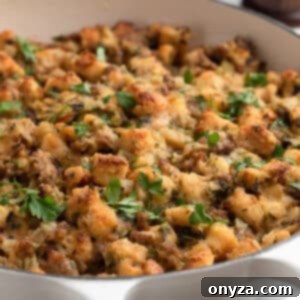
Italian Sausage Stuffing with Parmesan and Herbs
by Amanda Biddle
A timeless family favorite, this Italian Sausage Stuffing brings rich, hearty flavors to your holiday table, packed with savory sausage, nutty Parmesan, and aromatic fresh herbs. It’s the perfect companion for Thanksgiving turkey and any festive menu.
Prep Time: 1 hour 30 minutes
Cook Time: 1 hour 5 minutes
Resting Time: 10 minutes
Total Time: 2 hours 45 minutes
Servings: 12 servings
Ingredients
- 1½ pound loaf country white bread, cut into ½–¾-inch cubes (about 12 cups)
- 10 tablespoons unsalted butter, divided
- 1 pound sweet Italian sausage, bulk or casings removed from links
- 2 tablespoons chopped fresh sage
- 2 teaspoons chopped fresh thyme leaves
- ¼ teaspoon poultry seasoning (such as Bell’s Seasoning)
- 1 teaspoon Diamond Crystal kosher salt, plus additional to taste
- ½ teaspoon freshly-ground black pepper, plus additional to taste
- ¾ cup freshly-grated Parmigiano Reggiano
- ¼ cup chopped flat leaf parsley, plus extra for garnish
- 2¼ to 3 cups low-sodium turkey stock or chicken broth/stock
- 2 large eggs
Instructions
Make the Croutons
- Preheat oven to 250°F. Spread the bread cubes in a single layer on 2 rimmed half-sheet pans.
- Bake for 50–60 minutes, stirring and rotating the pans halfway through, until the cubes are well-dried with just a hint of toasty color.
- Cool completely at room temperature. You should have approximately 1 pound (12 cups) of croutons.
Cook the Sausage and Vegetables
- Melt 2 tablespoons butter in a large nonstick skillet over medium-high heat. Add the sausage and cook, breaking it into bite-sized crumbles, until browned and cooked through.
- Transfer the sausage to a large mixing bowl with a slotted spoon, leaving the drippings in the pan.
- Add 6 tablespoons of butter to the skillet. When melted, add the celery and onions. Cook over medium heat for 8–10 minutes, until softened but not browned.
- Stir in the sage, thyme, poultry seasoning, 1 teaspoon salt, and 1/2 teaspoon pepper. Cook for 1–2 minutes, until the herbs soften and the mixture is aromatic.
Assemble the Stuffing
- Add the cooled croutons, vegetable mixture (and all the butter from the pan), grated Parmigiano Reggiano, and chopped parsley to the mixing bowl with the sausage. Gently stir to mix everything together.
- Pour 1¾ cups of the stock over the mixture. Toss well and let sit for a few minutes so the bread can begin absorbing the liquid. Taste and adjust the seasoning with salt and pepper as needed (this is your last chance to taste before the eggs are added).
- Whisk the eggs with ½ cup stock. Pour over the stuffing, toss again, and let it stand a few minutes to absorb.
- Check the moisture level by gently squeezing a crouton. It should feel hydrated all the way through, but still hold its shape. Add additional stock as needed, ¼ cup at a time, until the stuffing is evenly moistened. Every loaf of bread absorbs liquid differently.
Bake
- Transfer the mixture to a buttered 3-quart gratin dish or 13×9-inch baking dish, spreading it evenly without packing it down.
- Cut the remaining 2 tablespoons of butter into small pieces and scatter them over the top of the stuffing.
- Cover the pan tightly with foil and bake at 375°F for 30 minutes.
- Remove the foil and bake for 15–20 minutes, until the top is golden and crisp and the center reaches 165°F.
- Let the stuffing stand for 10 minutes before sprinkling the top with a little extra chopped fresh parsley and serving.
Notes
1. Bread: For the best texture, use a hearty country-style white bread (not light, airy bread). I most often use Pepperidge Farm Farmhouse White or Arnold Country White. You do not need to remove the crusts from sandwich bread, and can use the end pieces. If you’re using a bread with a heavy crust, trim it off before cutting the bread cubes. Dry the bread cubes fully so they can absorb the broth without turning mushy. You should end up with about 1 pound (12 cups) of croutons from a 1½-pound loaf.
2. Sausage: Sweet Italian sausage with fennel is traditional in my family’s version (Premio is a good brand if you’re shopping at the regular grocery store), but hot Italian sausage or a mix of both works well. If using links, remove the casings before browning.
3. Poultry Seasoning: I use and recommend Bell’s Seasoning, a salt-free blend containing rosemary, oregano, sage, ginger, marjoram, thyme, and pepper. If you’re unable to source Bell’s, be sure the poultry seasoning you’re using contains similar herbs and spices, without added salt.
4. Salt and Pepper: Seasoning amounts will vary based on the saltiness of your broth, the seasoning in your sausage, and your personal preferences. Taste and adjust with additional salt and pepper before adding the raw eggs.
5. Broth or Stock: The amount you’ll need depends on how dry your bread is and how moist you prefer your stuffing. Start conservatively and add more as needed. Homemade turkey stock should be fully thawed and gently warmed if gelled. If using store-bought broth, be sure to buy a low-sodium brand so you can control the salt level of the stuffing. I like Pacific Foods Organic Low Sodium Chicken Broth (50 mg sodium per cup).
Nutrition Estimate
Serving: 0.08 recipe | Calories: 427kcal | Carbohydrates: 31g | Protein: 16g | Fat: 27g | Saturated Fat: 12g | Polyunsaturated Fat: 3g | Monounsaturated Fat: 9g | Trans Fat: 0.4g | Cholesterol: 91mg | Sodium: 939mg | Potassium: 258mg | Fiber: 1g | Sugar: 4g | Vitamin A: 511IU | Vitamin C: 3mg | Calcium: 217mg | Iron: 3mg
Nutrition information is an estimate and should be used as an approximation only.
